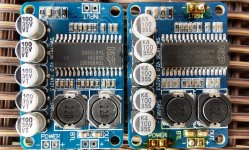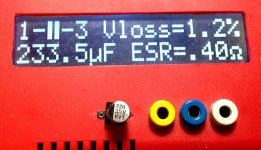I too had one DOA,and one ok. Seller refunded the $ for one bad one. I ordered another.
Do your boards have the Sanwu name on them? Mine don't, and they look "cheaper" made than my TPA3118 Sanwu boards. Probably a copy?
Do your boards have the Sanwu name on them? Mine don't, and they look "cheaper" made than my TPA3118 Sanwu boards. Probably a copy?
Thank you for checking on that! I've also been prowling the rather large datasheet.I have been listening to this amp for past couple of hours and my opinion of its sound quality has increased. The OP is correct about the nice smooth non fatiguing sound. The lack of fatigue may also be in part due to the standard 10R+470pF bootstrap snubber as standard issue. I noticed it upon visual inspection and confirmed in Fig 37 of spec sheet.
http://www.nxp.com/documents/data_sheet/TDA8932B.pdf
http://www.nxp.com/documents/data_sheet/TDA8932B.pdf
I just soldered the 47u cap, the datasheet refers to as chvpref. It is may be a delay timer used for SE mode, or an entirely different function altogether.
Do you guys in the Class D forum have smaller size soldering irons? My big Radio Shack 30 watt iron has a tip larger than the ecaps on this board, and I *may* have been foaming at the mouth for the 3 minutes it took to do this.
It (#chvpref) didn't provide an instant, convenient solution for using SE mode. So, I'm going to have to hook up the charge lines, HPV1, HPV2.
Momentary backstory: On this chip SE mode will deliver rather high fidelity (theoretically more than double) at the cost of having less output power (theoretically, 2/3rds). You don't lose the placid tone feature.
In SE mode, the SANWU board (in my opinion) beats that T-amp stuff by an incredible extent.
I'm rocking the house on six watts of hi-fi. Obviously, this amplifier has both a tame clipping pattern and a flexible zero point reference. In combination, the cost of using SE mode isn't so dear.
I have a couple different variances of this board. The one with the power caps labeled A5, 100, 35s is pretty good. However, the one with the power caps labeled 100, 35v, vt is higher resolution. I put that one, in SE mode, on a better quality power supply. It did high end sound. First time I ever heard that un-tainted high-resolution quality from a Class D amplifier.
The problem is that am still in need of a higher power mono amp. For this, I just hooked up the TDA8950. Big bro. He is doing okay, but not as glorious due to a very poor quality onboard power supply. Okay, it is *almost* glorious, so much that I don't regret buying it. It has the same fantastic bass and same placid tone. The resolution is doing fine. Sound like the best AB amp ever made if equipped with an idiot's power supply. That's at least factual. And, it will be easy to mod. Bear in mind, I have just now swapped them. Little bro is better (in SE mode); however, big bro managed a surprisingly good performance, and really very similar. That is here: http://www.diyaudio.com/forums/class-d/287919-big-bro-tda8950.html#post4637837
Edit: Big bro is surprisingly similar. Also, a bit louder.
Do you guys in the Class D forum have smaller size soldering irons? My big Radio Shack 30 watt iron has a tip larger than the ecaps on this board, and I *may* have been foaming at the mouth for the 3 minutes it took to do this.
Very timely... we are having lots of fun with an OT discussion of smaller tip soldering irons, desoldering irons, etc. over in 3118 thread. I have a 20 year old Weller and using a 0.032in tip that is still too big. Need the 0.015in tip but tips cost almost 1/4th of iron cost. So maybe worth it to upgrade to a $70 solder rework station with hot air gun.
Discussion on soldering irons and tools for SMT etc starts here and has been going on for pages - lots of useful info from pros who work SMT everyday.
http://www.diyaudio.com/forums/class-d/219730-tpa3118d2-54.html
Try and IRS2092 - needs dual rail, but $20 Abeltec SMPS and $15 IRS2092 can get you 200 watts clean. Threads for each:
http://www.diyaudio.com/forums/class-d/275915-200w-irs2092-amp-20-a.html
http://www.diyaudio.com/forums/class-d/281698-abletec-53v-dual-rail-450w-supply-20-a.html
Btw, the $14 TDA7498 (supposedly capable of 100w) sounds nice but needs 32v single supply for 100w.
In SE mode, the SANWU board (in my opinion) beats that T-amp stuff by an incredible extent.
I agree that this is perhaps one of the finest sounding amps below 10w, regardless of price.
The Sanwu 3118 PBTL with 26dB gain mod is perhaps the best 30w amp (capable of 60w - I tested myself). It doesn't need anything other than swap gain resistors and RTV to a heatsink on bottom to help dissipate heat as PCB is too small to be a heatsink.
Lately though, I am experimenting with discrete transistor class AB amps and am impressed by their bass authority vs these little postage stamp sized amps. Not surprising given one of the BJT's is about the same size as the Sanwu PCB.
With 8 ohm speaker, 19v, and SE mode, is under 10 watts?
Yes, so says the datasheet.
However! My power meter says 11 watts.
That's just 6db less speaker output than the TDA8950.
Yes, so says the datasheet.
However! My power meter says 11 watts.
That's just 6db less speaker output than the TDA8950.
My TDA7293 Parallel amp thread does have the bass authority and placid/friendly tone as well. It did flip my chair! That is not the stock condition; however, the mods to get it to do that, are documented on the thread. It does 90W per channel (and regular peaks to more than 130W if 4 ohm speakers are connected). Due to excellent stability while also running a speaker (if modded as indicated) it doesn't require a large heatsink. If running an 8 ohm speaker, the heatsink can be half the norm for a Class aB amp. You might not need the amp (the scale is too big for a normal house), but do have a look at the mods. 😀Lately though, I am experimenting with discrete transistor class AB amps and am impressed by their bass authority vs these little postage stamp sized amps. Not surprising given one of the BJT's is about the same size as the Sanwu PCB.
My TDA7293 Parallel amp thread does have the bass authority and placid/friendly tone as well. It did flip my chair!
I have gone through the thread - interesting looking amp. Right now I am playing with Destroyer X's Dx amp. Running it off a pair of 19v laptop smps bricks (measured 19.9v) dual rail supply. I think it will sound better when I get 33v supply as it was designed for. The Dx amp sounds very nice - quite a bit of bass authority and overall very good sound quality. I am using a kit from LJM as I can't make my own PCB and don't want to bother with getting the BOM myself.
2pcs 100W+100W DIYAudio "destroyer X" DXAMP Amplifier kit-in Amplifier from Consumer Electronics on Aliexpress.com | Alibaba Group
I have gone through the thread - interesting looking amp. Right now I am playing with Destroyer X's Dx amp. Running it off a pair of 19v laptop smps bricks (measured 19.9v) dual rail supply. I think it will sound better when I get 33v supply as it was designed for. The Dx amp sounds very nice - quite a bit of bass authority and overall very good sound quality. I am using a kit from LJM as I can't make my own PCB and don't want to bother with getting the BOM myself.
2pcs 100W+100W DIYAudio "destroyer X" DXAMP Amplifier kit-in Amplifier from Consumer Electronics on Aliexpress.com | Alibaba Group
That design is similar to: http://www.diyaudio.com/forums/solid-state/145306-rca-1972-basic-amplifier-mods.html by OStripper.
It is neither likely nor impossible for that to achieve as much fidelity as our TDA8932 in SE mode. However, the bigger output devices certainly could achieve a louder output, somewhat 6db, and it might could do it attractively. At the point, a preference might depend on what size house you have. Today, we, here, had a discussion about the differences of a more powerful amplifier. That does exist, but it isn't easy.
Last edited:
Although the TDA8932 in factory condition bridge mode is not quite interesting enough, I got some news! In SE mode (add 47u delay cap, add charge lines for output caps, add output caps at v-, datasheet says how), it makes a flea power amp that I look forward to hearing.
After that?
For midranges and tweeters and other small speakers, does this have a peer?
Nope. Nothing beats that. And, it isn't likely that anything will.
So, I'm exploring the bi-amp thing.
The TDA8932 in SE mode sounds like a small amp, not a big amp, and there's a cost at lifelike dynamics, which takes power. I got this! But I'd rather it cost less. Let's see what happens.
After that?
For midranges and tweeters and other small speakers, does this have a peer?
Nope. Nothing beats that. And, it isn't likely that anything will.
So, I'm exploring the bi-amp thing.
The TDA8932 in SE mode sounds like a small amp, not a big amp, and there's a cost at lifelike dynamics, which takes power. I got this! But I'd rather it cost less. Let's see what happens.
Enclosure started
This is an ordinary plastic project box with a metal plate, a very useful metal plate.
After some light drilling, I will be able to bolt the metal plate to the top of the box as shown positioned in the attached photo. It could look better with some pinstripe tape and some metal knobs added.
The plan is to cut away most of the top of the box, secure the amplifier to the metal plate with some kapton or thermal interface pad and bolt that too, and drill holes, not much smaller than my finger, in the bottom of the box.
There will be 8 screws showing on top of the box, but the amplifier will be inside.
Due to adding some significant stick-on feet, air will go through holes in the bottom of the box, crowd around the amplifier (bolted upside down to that metal plate at the top of the box) blow through that big hole at the top of the box, crowd around the metal plate relieving it of heat and cooling off the amplifier with no fan required.
On the back of the box, positioned way down low (to prevent flipping over backwards), I plan to use Monster oversize speaker terminals, in their much cheaper form without the gold plating. That would be these: Two Conductor Speaker Wire Spring Terminal Note the 12ga capacity. These are huge. I like them because the spring is very strong and assures good contact (there's doubled contact surfaces) at the first minute and afterwards as well.
This is an ordinary plastic project box with a metal plate, a very useful metal plate.
After some light drilling, I will be able to bolt the metal plate to the top of the box as shown positioned in the attached photo. It could look better with some pinstripe tape and some metal knobs added.
The plan is to cut away most of the top of the box, secure the amplifier to the metal plate with some kapton or thermal interface pad and bolt that too, and drill holes, not much smaller than my finger, in the bottom of the box.
There will be 8 screws showing on top of the box, but the amplifier will be inside.
Due to adding some significant stick-on feet, air will go through holes in the bottom of the box, crowd around the amplifier (bolted upside down to that metal plate at the top of the box) blow through that big hole at the top of the box, crowd around the metal plate relieving it of heat and cooling off the amplifier with no fan required.
On the back of the box, positioned way down low (to prevent flipping over backwards), I plan to use Monster oversize speaker terminals, in their much cheaper form without the gold plating. That would be these: Two Conductor Speaker Wire Spring Terminal Note the 12ga capacity. These are huge. I like them because the spring is very strong and assures good contact (there's doubled contact surfaces) at the first minute and afterwards as well.
Attachments
Quality varies with production, see photo
On the right, is the originally reviewed part which does mid-fi in BTL mode or somewhat better quality in SE mode. It is more useful in SE mode. However...
On the left is a newer purchase, I got two of them and am currently using its twin. The amp on the left does good quality in BTL or close enough to high end in SE mode. It is serviceable in either mode.
The printing on both the caps and chips is different. Which one do you have?

On the right, is the originally reviewed part which does mid-fi in BTL mode or somewhat better quality in SE mode. It is more useful in SE mode. However...
On the left is a newer purchase, I got two of them and am currently using its twin. The amp on the left does good quality in BTL or close enough to high end in SE mode. It is serviceable in either mode.
The printing on both the caps and chips is different. Which one do you have?

Attachments
Last edited:
Mine appears to be the RVT cap variant - so not like either of yours, is it better to have an RVT cap vs VT cap?
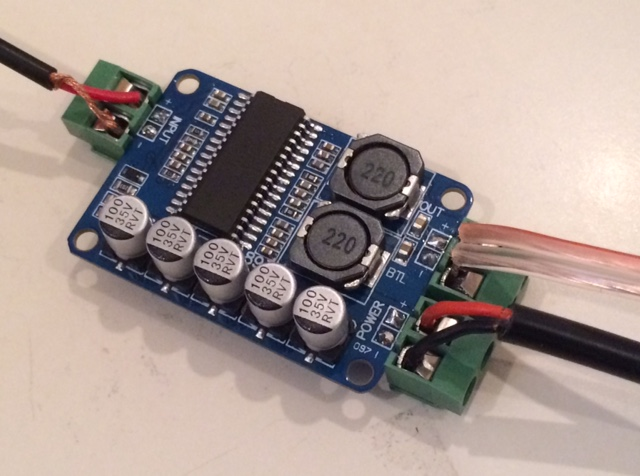

If geniue, datasheet will tell.
Who is the vendor? If it is "fuhjyyu", then have a look here:
http://www.fuhjyyu.com.tw/images/pdf/RVT.pdf
Pretty descent stuff.. not. 😀
If they're the bigger ones, there is 125mA*1.5 (correction factor) * 5 = 938mA ripple capability for the whole bank. As the dissipation factor is only given for 120Hz, we can calc the ESR at this frequency to:
ESR(120Hz) = DF/2*pi*f*C = 0.16/2*pi*120Hz*100uF = 2.1Ohm each
-----------------------------------
But from the picture i miss the venting cross.
Who is the vendor? If it is "fuhjyyu", then have a look here:
http://www.fuhjyyu.com.tw/images/pdf/RVT.pdf
Pretty descent stuff.. not. 😀
If they're the bigger ones, there is 125mA*1.5 (correction factor) * 5 = 938mA ripple capability for the whole bank. As the dissipation factor is only given for 120Hz, we can calc the ESR at this frequency to:
ESR(120Hz) = DF/2*pi*f*C = 0.16/2*pi*120Hz*100uF = 2.1Ohm each
-----------------------------------
But from the picture i miss the venting cross.
Last edited:
Regardless, the amp sounds fantastic. 🙂 I have a dead unit and can pull the caps off the measure the C and ESR with my LCR meter.
I found one of those RVT caps in a small buck converter and put in on the ESR meter.
RVT 220uF 35V
measured
233.5uF (+/-2%) ESR(10kHz)=400mR 1.2% dissipation.
smaller capacitance usually leads to higher ESR.
Picture of proof attached.
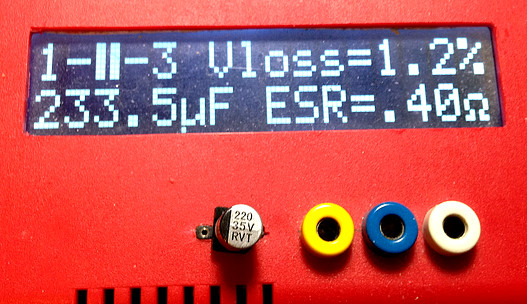
Maybe they are from different "brand" as they feature a venting-cross.
RVT 220uF 35V
measured
233.5uF (+/-2%) ESR(10kHz)=400mR 1.2% dissipation.
smaller capacitance usually leads to higher ESR.
Picture of proof attached.
Maybe they are from different "brand" as they feature a venting-cross.
Attachments
Mine appears to be the RVT cap variant - so not like either of yours, is it better to have an RVT cap vs VT cap?

Yours looks just like mine, but Daniel's are different, his labeled "Sanwu" brand, mine are not.
Neither look like the poor caps example. I can't tell you for sure because I have only one of them (practical comparison hindered). Also compare the chips. Which one to you have? The "T" or the "BT"? See photo posted just earlier. By your reports, your good board and my good board are *very similar*. Please say more about the printing atop that chip?Mine appears to be the RVT cap variant - so not like either of yours, is it better to have an RVT cap vs VT cap?
I'd like to know if the relevant difference was chip or caps. That's the question.
How much it may cost for the audio quality difference between the two different samples that I received in the mail, isn't something that I'm prepared to describe because it is surprising. However, in one case, I can say that a limit to performance of the chip itself, wasn't identifiable. The other one was reviewed previously. There is a difference. I need to know where (locale) that is.
Looking closely, the amp on the right is using the older TDA8932T, that on the left has the updated TDA8932BT. From the datasheets the difference I noticed is that the newer 'B' suffix part has 1Mohm resistors integrated on the chip - the older (no 'B') part needs those 1Mohm resistors fitted on to the PCB. But the board is clearly laid out for the 'B' part as those resistors are nowhere to be seen.
You could try adding 1Mohm resistors (across the 15nF bootstrap caps, between pins 21/22 and 27/28) to the amp on the right and see if that helps with the SQ in BTL.
You could try adding 1Mohm resistors (across the 15nF bootstrap caps, between pins 21/22 and 27/28) to the amp on the right and see if that helps with the SQ in BTL.
Thank you for telling us that a chip difference exists.Looking closely, the amp on the right is using the older TDA8932T, that on the left has the updated TDA8932BT. From the datasheets the difference I noticed is that the newer 'B' suffix part has 1Mohm resistors integrated on the chip - the older (no 'B') part needs those 1Mohm resistors fitted on to the PCB. But the board is clearly laid out for the 'B' part as those resistors are nowhere to be seen.
You could try adding 1Mohm resistors (across the 15nF bootstrap caps, between pins 21/22 and 27/28) to the amp on the right and see if that helps with the SQ in BTL.
I had a plan to toy with the older, slightly lackluster, variant for experiments. Apparently, I need to add the missing parts before then. Thanks for the help.
Last edited:
New trend, eh? I am mostly satisfied with TPA3116 Audiobah board, but I am definitely going to try this one. Any way to ensure the BT version?
And did anyone notice the red boards, almost double the price?
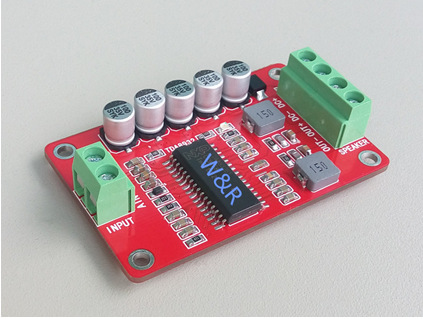
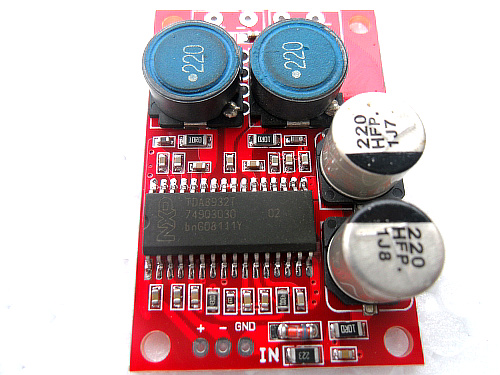
There is also a 2-Ch bluetooth version.
And did anyone notice the red boards, almost double the price?


There is also a 2-Ch bluetooth version.
Last edited:
I would certainly like a board that has 1 chip (BT version or BTW version), 2 channels (stereo, SE mode).There is also a 2-Ch bluetooth version.
Mods to do on it would be upgrading to just-right-size (no smaller than useful, because bass. And no larger than necessary, because efficiency and headroom) speaker dc filter caps. What comes with the stereo board probably suits 4" woofers. But the caps are physically large, so soldering on an upgrade would be easy.
Last edited:
- Home
- Amplifiers
- Class D
- Fasten seat belts. TDA8932 pessimistic review.
![20160317_173653[1].jpg](/community/data/attachments/491/491247-008d16fff85f52fd3d980cda32da2d4b.jpg?hash=AI0W__hfUv)
